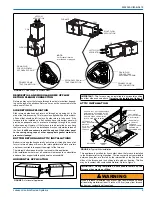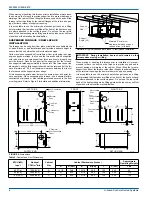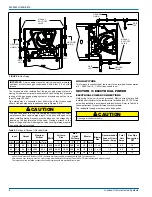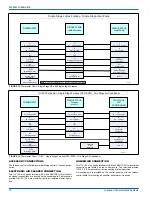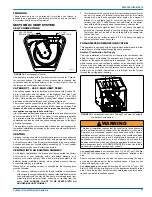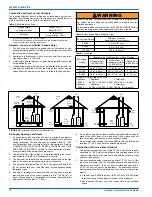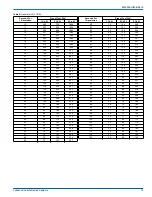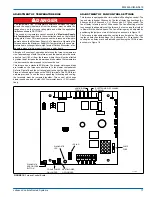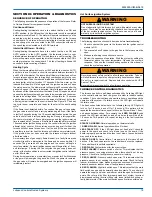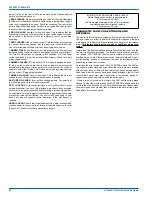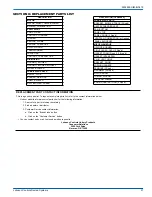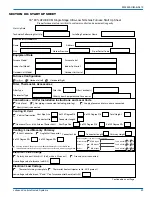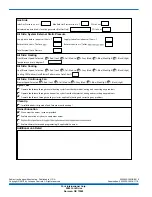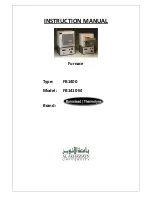
5532522-UIM-B-0619
Johnson Controls Ducted Systems
19
SECTION IX: OPERATION & DIAGNOSTICS
SEQUENCE OF OPERATION
The following describes the sequence of operation of the furnace. Refer
to Owners Manual for component location.
Continuous Blower
Cooling/heating thermostats have a fan switch that has an ON and
AUTO position. In the ON position, the thermostat circuit is completed
between terminals R and G. The motor will operate continuously on the
speed tap wire that is connected to the FAN terminal on the furnace
control board. To obtain a different circulating fan (continuous blower)
speed, change the wire connected to the FAN connection with one of
the speed tap wires located on the PARK terminals.
Intermittent Blower - Cooling
Cooling/heating thermostats have a fan switch that has an ON and
AUTO position. In the AUTO position, the thermostat circuit is com-
pleted between terminals R and G when there is a call for cooling. The
motor will operate on the speed tap wire that is connected to the COOL
cooling terminal on the control board. The fan off setting is fixed at 60
seconds to improve cooling efficiency.
Heating Cycle
When the thermostat switch is set on HEAT and the fan is set on AUTO,
and there is a call for heat, a circuit is completed between terminals R
and W of the thermostat. The induced draft blower will start and will run
for several seconds in order to bring fresh combustion air into the com-
bustion chamber. Then the induced draft blower will shut off and the hot
surface igniter will glow for about 17 seconds. After this warm up, the
induced draft blower will start again and the ignition module will open
the main gas valve. The blower motor will energize 30 seconds after the
gas valve opens, if a flame is detected. Normal furnace operation will
continue until the thermostat circuit between R and W is opened, which
causes the ignition system and gas valve to de-energize and the burner
flames to be extinguished. The vent motor will operate for 15 seconds
and the blower motor will operate for the amount of time set by the fan-
off delay jumper located on the control board. See Figure 19. The heat-
ing cycle is now complete, and ready for the start of the next heating
cycle.
If the flame is not detected within 7 seconds of the gas valve opening,
the gas valve is shut off and a retry operation begins. Also, if the flame
is lost for 2 seconds during the 10-second stabilization period, the gas
valve is shut off and a retry operation begins. During a retry operation,
the vent motor starts a 15 second inter-purge and the ignitor warm-up
time is extended to 27 seconds. If the flame is established for more than
10 seconds after ignition during a retry, the control will clear the ignition
attempt (retry) counter. If three retries occur during a call for heat, the
furnace will shut down for one hour. If at the end of the one hour shut
down there is a call for heat, the furnace will initiate a normal start cycle.
If the problem has not been corrected the furnace will again lockout
after three retries.
A momentary loss of gas supply, flame blowout, or a faulty flame probe
circuit will result in a disruption in the flame and be sensed within 1.0
seconds. The gas valve will de-energize and the control will begin a
recycle operation. A normal ignition sequence will begin after a 15 sec-
ond inter-purge. If during the five recycles the gas supply does not
return, or the fault condition is not corrected the ignition control will lock-
out for 60 minutes.
During burner operation, a momentary loss of power for 50 milliseconds
or longer will de-energize the gas valve. When the power is restored,
the gas valve will remain de-energized and the ignition sequence will
immediately restart.
Hot Surface Ignition System
TROUBLESHOOTING
The following visual checks should be made before troubleshooting:
1. Check to see that the power to the furnace and the ignition control
module is ON.
2. The manual shut-off valves in the gas line to the furnace must be
open.
3. Make sure all wiring connections are secure.
4. Review the sequence of operation. Start the system by setting the
thermostat above the room temperature. Observe the system’s
response. Then use the troubleshooting section in this manual to
check the system’s operation.
FURNACE CONTROL DIAGNOSTICS
The furnace has built-in, self-diagnostic capability. A blinking LED light
on the control board can flash red, green or amber to indicate various
conditions. The control continuously monitors its own operation and the
operation of the system. If a failure occurs, the LED light will indicate
the failure code.
The flash codes listed below have the following timing: LED light will
turn on for 1/4 second and off for 1/4 second. This pattern will be
repeated the number of times equal to the code. There will be a 1.5 sec-
ond pause between codes. For example, the
6 RED FLASHES
code
means the LED light will flash on and off six times, then will be off for
1.5 seconds. This pattern will repeat as long as the fault condition
remains.
STEADY ON GREEN:
Normal operation, no thermostat calls.
1 GREEN FLASH:
Normal operation with call for heat.
LED STEADY OFF:
If the LED light does not flash at all, check for
power to the board and check for a blown fuse on the board. If the
board is properly powered and the fuse is not blown, the control board
may need to be replaced.
STEADY ON RED:
Control failure. Turn power to the furnace off and
back on. If the fault code returns, the control board must be replaced.
The control board is not field-repairable.
1 RED FLASH:
System lockout for too many retries.
2 RED FLASHES:
Pressure switch null error. This indicates that the
pressure sensor is sensing pressure when there should not be any
pressure. Check for a faulty pressure sensor or miswiring.
3 RED FLASHES:
Pressure switch span error. This indicates that the
pressure sensor is not sensing the correct pressure. Check for faulty
inducer, blocked vent pipe, broken pressure sensor hose, disconnected
pressure sensor or inducer wires or faulty pressure sensor.
4 RED FLASHES:
High limit switch open. This indicates that the main
limit switch has opened its normally closed contacts. The control will
operate the supply air blower and inducer while the open limit condition
exists. Check for a dirty filter, improperly sized duct system, incorrect
blower speed setting, incorrect firing rate, loose limit switch wiring, or
faulty blower motor. If the main limit switch opens five times within a sin-
WARNING
HOT SURFACE IGNITION SYSTEM
Do not attempt to light this furnace by hand (with a match or any other
means). There may be a potential shock hazard from the components
of the hot surface ignition system. The furnace can only be lit auto-
matically by its hot surface ignition system.
WARNING
Never bypass any safety control to allow furnace operation. To do so
will allow furnace to operate under potentially hazardous conditions.
Do not try to repair controls. Replace defective controls with UPG
Source 1 Parts.
Never adjust pressure switch to allow furnace operation.
!
!

